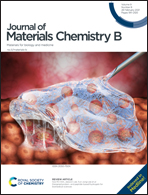Difunctionalized pillar[5]arene-based polymer nanosheets for photodynamic therapy of Staphylococcus aureus infection†
Abstract
Bacterial infections pose severe threats to global public health security. Developing antibacterial agents with both high efficiency and safety to handle this problem has become a top priority. Here, highly stable and effective polymer nanosheets have been constructed by the covalent co-assembly of a pillar[5]arene derivative and metalloporphyrin for photodynamic antibacterial therapy (PDAT). The monolayer nanosheets are strongly positively charged and thus capable of binding with Staphylococcus aureus (SA) through electrostatic interactions. Additionally, the nanosheets can be activated to generate reactive oxygen species (ROS) under white-light irradiation, and exhibit satisfactory antibacterial performance towards SA. More importantly, cell viability assays demonstrate that the nanosheets show little to no cytotoxicity impact on mammalian cells even when the concentrations are much higher than those employed in the antibacterial studies. The above results suggest that the polymer nanosheets could be an effective antibacterial agent to overcome bacterial infections and hold a broad range of potential applications in real life.
![Graphical abstract: Difunctionalized pillar[5]arene-based polymer nanosheets for photodynamic therapy of Staphylococcus aureus infection](/en/Image/Get?imageInfo.ImageType=GA&imageInfo.ImageIdentifier.ManuscriptID=D0TB02786C&imageInfo.ImageIdentifier.Year=2021)


 Please wait while we load your content...
Please wait while we load your content...